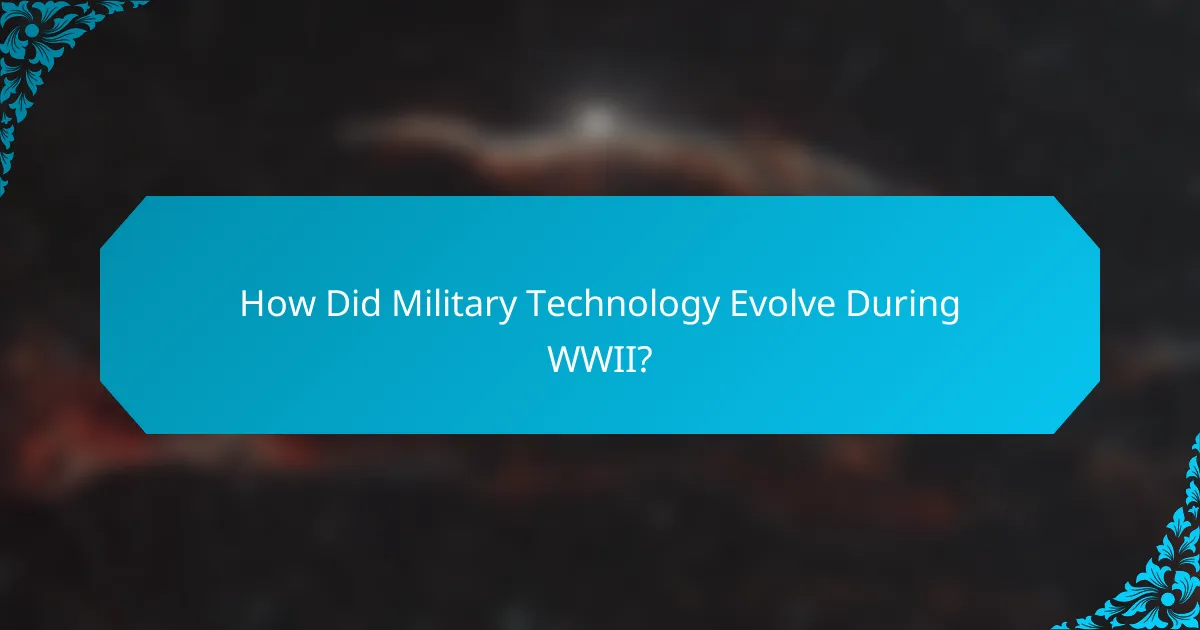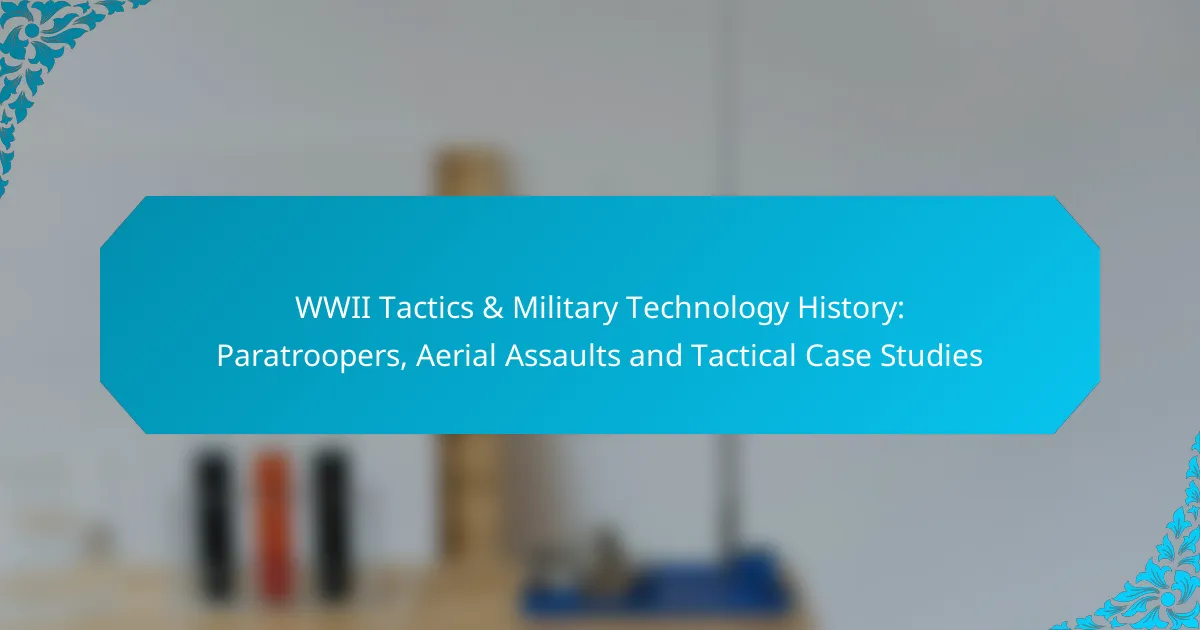World War II was marked by the critical importance of air superiority, which greatly influenced the success of military operations and the overall outcome of the conflict. Key tactics employed during D-Day, including meticulous planning and deception, were essential for establishing a foothold in Normandy, while the Allies leveraged superior intelligence and advanced technology to gain tactical advantages across multiple fronts.

How Did Air Superiority Influence WWII Outcomes?
Air superiority was a decisive factor in World War II, significantly impacting the outcomes of battles and campaigns. Control of the air allowed forces to conduct operations with reduced risk from enemy aircraft, enabling more effective ground assaults and strategic bombings.
Control of the Skies
Control of the skies meant that a military could operate freely without the threat of enemy air attacks. This dominance was achieved through effective fighter aircraft and strategic bombing campaigns that targeted enemy airfields and infrastructure. The Allies, particularly during the D-Day operations, demonstrated how air superiority facilitated troop movements and landings.
Impact on Ground Operations
Ground operations were profoundly affected by air superiority, as it provided vital support through close air support missions and reconnaissance. With air cover, ground troops could advance with less fear of ambushes from above, leading to quicker and more successful offensives. For instance, during the Normandy invasion, Allied air forces played a crucial role in disrupting German defenses before the landings.
Key Air Forces Involved
Several key air forces played pivotal roles in achieving air superiority during WWII. The United States Army Air Forces (USAAF) and the Royal Air Force (RAF) were instrumental in the European theater, employing strategies that included strategic bombing and fighter escorts. Meanwhile, the Luftwaffe, Germany’s air force, initially held significant power but struggled to maintain dominance as the war progressed.
Technological Innovations
Technological innovations greatly enhanced air capabilities during WWII. Advancements in aircraft design, such as the introduction of long-range bombers and faster fighter planes, allowed for more effective operations. Radar technology also improved detection and interception of enemy aircraft, contributing to the overall effectiveness of air campaigns.

What Were the Key Tactics Used in D-Day Operations?
The key tactics used in D-Day operations included extensive planning, deception strategies, and coordinated assaults across air, land, and sea. These tactics aimed to establish a foothold in Normandy, which was crucial for the Allied invasion of Europe.
Operation Overlord Overview
Operation Overlord was the codename for the Allied invasion of Nazi-occupied Europe, commencing on June 6, 1944. This operation involved meticulous planning and coordination among multiple nations, primarily the United States, United Kingdom, and Canada. The objective was to secure the beaches of Normandy and facilitate the liberation of Western Europe.
The operation was divided into phases, starting with aerial bombardments and naval support, followed by the amphibious landings on five designated beaches: Utah, Omaha, Gold, Juno, and Sword. Each beach had specific strategic importance and required tailored tactics to overcome German defenses.
Amphibious Assault Strategies
Amphibious assault strategies during D-Day involved a combination of surprise, overwhelming force, and effective use of specialized landing crafts. The Allies employed various types of landing vehicles, such as LCVPs (Landing Craft, Vehicle, Personnel), to transport troops and equipment directly onto the beaches.
One key tactic was the use of artificial harbors, known as Mulberry harbors, which allowed for the rapid offloading of supplies and reinforcements after the initial landings. This logistical support was vital for sustaining the invasion and expanding the beachhead.
Air and Naval Support Coordination
Effective coordination of air and naval support was crucial for the success of D-Day operations. Prior to the landings, Allied aircraft conducted extensive bombing campaigns to destroy German fortifications and disrupt supply lines. This air superiority was essential for minimizing casualties during the beach assaults.
Naval forces provided direct fire support to ground troops, targeting enemy positions along the coastline. The synchronization of air and naval operations ensured that troops landed with the best possible chance of success, significantly contributing to the overall effectiveness of the invasion.

What Tactical Advantages Did the Allies Have?
The Allies gained significant tactical advantages during World War II through superior intelligence, robust logistical support, and advanced technology. These factors played a crucial role in their success on various fronts, particularly during pivotal operations like D-Day.
Intelligence and Deception Operations
The Allies excelled in intelligence and deception, which misled Axis forces about their true intentions. Operations like Operation Fortitude, which created a fictitious army in Southeast England, diverted German attention away from the actual D-Day landing site.
Effective use of codebreaking, especially the deciphering of the Enigma machine, allowed the Allies to anticipate enemy movements and strategies. This intelligence advantage enabled them to make informed decisions and adjust their tactics in real-time.
Logistical Support and Supply Chains
Logistical support was a cornerstone of Allied operations, ensuring that troops were well-equipped and supplied. The establishment of the Red Ball Express, a truck convoy system, facilitated the rapid transport of supplies to front-line units after D-Day.
Allies prioritized maintaining open supply lines, which were critical for sustaining operations. The ability to move large quantities of equipment and resources efficiently contributed to their operational success and resilience against counterattacks.
Use of Technology and Equipment
The Allies leveraged advanced technology and equipment to gain an edge in combat. Innovations such as the landing craft used during D-Day allowed for effective troop deployment on hostile shores, significantly enhancing their amphibious assault capabilities.
Additionally, the use of aircraft for air superiority, including fighter planes like the P-51 Mustang, provided critical support for ground operations. This technological advantage not only protected Allied forces but also disrupted enemy supply lines and communications.

How Did Military Technology Evolve During WWII?
During World War II, military technology underwent rapid advancements that significantly changed warfare dynamics. Key innovations in aircraft, armored vehicles, and communication systems played crucial roles in achieving air superiority and operational success.
Advancements in Aircraft Design
Aircraft design evolved dramatically during WWII, focusing on speed, agility, and firepower. Fighters like the P-51 Mustang and the Messerschmitt Bf 109 showcased improved aerodynamics and powerful engines, enabling them to engage effectively in dogfights.
Bombers such as the B-17 Flying Fortress and the Lancaster introduced strategic bombing capabilities, allowing for large payloads and long-range missions. These advancements contributed to the Allies’ ability to disrupt enemy supply lines and infrastructure.
Development of Tanks and Armored Vehicles
The development of tanks and armored vehicles was pivotal in ground warfare during WWII. Tanks like the Sherman and the T-34 featured better armor, mobility, and firepower, which allowed them to dominate the battlefield.
Armored divisions utilized combined arms tactics, integrating infantry and artillery support to enhance their effectiveness. This synergy often led to breakthroughs in enemy lines and significant territorial gains.
Innovations in Communication Systems
Communication systems saw significant innovations that improved coordination and strategy execution. The introduction of radio technology allowed for real-time communication between units, enhancing command and control during operations.
Devices like the SCR-300 backpack radio enabled mobile units to maintain contact over long distances, facilitating quicker decision-making and more effective responses to battlefield changes. This technological leap was essential for successful operations like D-Day.

What Were the Major Challenges Faced During D-Day?
The major challenges faced during D-Day included unpredictable weather, strong German defensive strategies, and the need for effective casualty management. Each of these factors significantly impacted the planning and execution of the Allied invasion on June 6, 1944.
Weather Conditions
Weather conditions on D-Day were a critical challenge, as poor visibility and rough seas threatened to derail the invasion. The original assault date was postponed due to a storm, and even on the chosen day, conditions remained less than ideal, with low clouds and choppy waters complicating air and naval operations.
Allied commanders had to rely on forecasts and make quick decisions, which highlighted the importance of accurate meteorological data. The successful invasion hinged on a brief window of improved weather, allowing for air support and troop landings on the beaches of Normandy.
German Defensive Strategies
The German forces had fortified the French coastline with extensive defenses known as the Atlantic Wall, which included bunkers, minefields, and obstacles designed to repel an invasion. These preparations posed significant challenges for the Allied troops, who faced heavy resistance upon landing.
German commanders were well aware of the potential for an Allied invasion and had positioned troops strategically along the coast. The effectiveness of their defensive strategies meant that Allied forces had to adapt quickly to overcome fortified positions and secure beachheads.
Casualty Management
Casualty management was a pressing concern during D-Day, as the initial landings resulted in high numbers of wounded and killed. Effective triage and medical evacuation were essential to maintain morale and combat effectiveness among the troops.
Allied planners established medical units close to the front lines to provide immediate care, but logistical challenges often delayed treatment for many soldiers. Ensuring adequate supplies and personnel for medical support was crucial in mitigating the impact of casualties on the overall operation.

How Did WWII Tactics Shape Modern Warfare?
World War II tactics significantly influenced contemporary military strategies by emphasizing the importance of air superiority, combined arms operations, and rapid mobility. These tactics laid the groundwork for modern warfare, highlighting the integration of technology and strategic planning.
Air Superiority
Air superiority during WWII was crucial for successful military operations, allowing forces to control the skies and protect ground troops. This concept involves the ability to dominate aerial combat, which was achieved through advanced aircraft technology and strategic bombing campaigns.
For example, the Allies’ use of long-range bombers and fighter escorts helped to cripple enemy supply lines and infrastructure. Modern militaries continue to prioritize air superiority, employing advanced fighter jets and drones to maintain control over airspace in conflicts.
D-Day Operations
The D-Day invasion exemplified the effective coordination of land, air, and naval forces, showcasing the importance of joint operations. This large-scale assault involved meticulous planning, deception tactics, and the use of specialized landing crafts to ensure the success of Allied forces on the beaches of Normandy.
Today, military operations often mirror the D-Day approach by emphasizing interoperability among different branches of the armed forces. This integration allows for more effective responses to complex battlefield scenarios, ensuring that all units can work together seamlessly.
Tactical Advantages
WWII tactics introduced several key advantages, such as the use of combined arms and the element of surprise. The integration of infantry, armor, and artillery allowed for more flexible and adaptive strategies, enabling forces to exploit enemy weaknesses effectively.
Modern militaries continue to leverage these tactical advantages by employing technology, such as real-time intelligence and communication systems, to enhance decision-making on the battlefield. Understanding the lessons from WWII can help current military leaders develop strategies that capitalize on these enduring principles.



